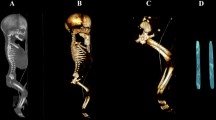Summary
Several anatomical parameters are useful in the assessment of gestational age. This work studies the foot length growth analysed against age, crown-rump length (C-R) and body weight (W) in eighty human fresh fetuses (staging from 14 to 38 weeks postconception). These data were correlated with the following statistical methods: simple regression, power formula (allometric method), exponential and reciprocal models. The foot length growth presents very high and statistically significant coefficients of correlations with fetal parameters (P<0.001); the allometric method was the best method for this analysis. Foot length grows with moderate (against the age and C-R) or slight (against the W) positive allometry. This study presents statistically significant curves of the foot length growth in relation to fetal parameters. These curves are useful in anatomy, forensic medicine, fetopathology, medical imaging, obstetrics and pediatrics.
Résumé
Plusieurs paramètres anatomiques sont utilisés pour estimer l'âge gestationnel. Ce travail étudie la longueur du pied comparée à l'âge gestationnel, à la taille vertex-coccyx et au poids du corps chez 80 fœtus humains non conservés (étagés de 14 à 38 semaines après la conception). Ces données sont étudiées selon les méthodes statistiques suivantes : simple régression, régression multiplicative (méthode allométrique), modèles exponentiels et réciproques. La longueur du pied présente un coefficient de corrélation très élevé et statistiquement significatif, avec les paramètres fœtaux (P<0,001). La méthode allométrique est la meilleure pour cette analyse. La longueur du pied croît avec une allométrie modérée (en comparaison avec l'âge et la taille vertex-coccyx) ou légère (en comparaison avec le poids). Cette étude a permis d'établir des courbes statistiquement significatives des rapports entre la longueur du pied et les paramètres fœtaux. Ces courbes sont utiles en anatomie, en médecine légale, en fœto-pathologie, en imagerie médicale, en obstétrique et en pédiatrie.
Similar content being viewed by others
References
Barros RSM, Mandarim-de-Lacerda CA (1989) Relative growth of the human metacarpals in the prenatal period: anatomic basis of preventive surgery for congenital deformities of the hand. Surg Radiol Anat 11: 49–52
Corruccini RS (1978) Relative growth and shape analysis. Homo 28: 222–226
Corruccini RS (1987) Shape in morphometrics:comparative analyses. Am J Phys Anthropol 73: 289–303
Gould SJ (1966) allometry and size in ontogeny and phylogeny. Biol Rev 41: 587–640
Gruenwald P (1966) Growth of the human fetus. I. Normal growth and its variation. Am J Obstet Gynecol 94: 1112–1119
Hattori K (1977) Studies on the growth of the Japanese fetuses. Part 1. Allometric growth of the external dimensions. Jikeikai Med J 24: 11–32
Huxley J (1932) Problems of relative growth. Methuen, London
Jeanty P, Romero R (1984) Estimation fo the gestational age. Seminars in Ultrasound, CT and MR 5: 121–129
Jolicœur P (1975) Linear regressions in fishery research:some comments. J Fish Res Board Can 32: 69–79
Kermack KA, Haldane JBS (1950) Organic correlation and allometry. Biometrika 37: 30–41
Kokoska SM, Johnson LB (1987) A comparison of statistical techniques for analysis of growth curves. Growth 51: 261–269
Mehta L, Singh HM (1972) Determination of crown-rump length from fetal long bones: humerus and femur. Am J Phys Anthropol 36: 165–168
Mercer BM, Sklar S, Shariatmadar A, Gillieson MS, D'Alton ME (1987) Fetal foot length as a predictor of gestational age. Am J Obstet Gynecol 156: 350–355
Ricker WE (1973) Linear regression in fishery research. J Fish Res Board Can 30: 409–434
Scammon RE (1937) Two simple nomographs for estimating the age and some of the major external dimensions of the human fetus. Anat Rec 68: 221–225
Scammon RE, Calkins LA (1924a) The relation between body-length and bodyweight in the human embryo and fetus. Proc Soc Exp Biol Med 21: 549–551
Scammon RE, Calkins LA (1924b) The relation between the body-weight and age of the human fetus. Proc Soc Exp Biol Med 22: 157–161
Scammon RE, Calkins LA (1929) The development and growth of the external dimensions of the human body in the fetal period. Univ Minnesota Press, Minneapolis
Schmidt-Nielsen K (1984) Scaling; why is animal size so important? Cambridge Univ Press, Cambridge
Sokal RR, Rohlf FJ (1981) Biometry, the principles and practice of statistics in biological research. Freeman, New York
Streeter GL (1920) Weight, sitting height, head size, foot length, and menstrual age of the human embryo. Contrib Embryol Carnegie Inst 11: 143–170
Takai S, Akiyoski T, Noriyasu S (1982) Change of body shape during the fetal period. Acta Med Jap 52: 10–14
Teissier G (1948) La relation d'allométrie: sa signification statistique et biologique. Biometrics 4: 14–48
Usher RL, McLean F (1969) Intrauterine growth of live-born caucasian infants born at sea level: standards obtained from measurements in 7 dimensions of infants born between 25 and 44 weeks of gestation. J Pediatr 74: 901–935
Vasconcellos HA, Mandarim-de-Lacerda CA (1988) Human metatarsal growth: an allometrical analysis in prenatal period. Arch Ital Anat Embriol 93: 155–162
Wylie B, Amidon B (1951) Correlation of weight, length, and time factors in fetal age. Am J Obstet Gynecol 61: 193–196
Author information
Authors and Affiliations
Rights and permissions
About this article
Cite this article
Mandarim-de-Lacerda, C. Foot length growth related to crown-rump length, gestational age and weight in human staged fresh fetuses. Surg Radiol Anat 12, 103–107 (1990). https://doi.org/10.1007/BF01623332
Received:
Revised:
Accepted:
Issue Date:
DOI: https://doi.org/10.1007/BF01623332




